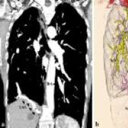Italian
Albanian
Arabic
Armenian
Azerbaijani
Belarusian
Bengali
Bosnian
Catalan
Czech
Danish
Deutsch
Dutch
English
Estonian
Finnish
Français
Greek
Haitian Creole
Hebrew
Hindi
Hungarian
Icelandic
Indonesian
Irish
Italian
Japanese
Korean
Latvian
Lithuanian
Macedonian
Mongolian
Norwegian
Persian
Polish
Portuguese
Romanian
Russian
Serbian
Slovak
Slovenian
Spanish
Swahili
Swedish
Turkish
Ukrainian
Vietnamese
Български
中文(简体)
中文(繁體)
BMC Pulmonary Medicine 2019-Apr
Solo gli utenti registrati possono tradurre articoli
Entra registrati
Il collegamento viene salvato negli appunti
RESULTS
In the switch group, median age, body weight, body mass index (BMI), and %FVC were 72 years old, 54.9 kg, 21.0 kg/m2, and 52.9%, respectively. Most common AE of nintedanib was aspartate aminotransferase/alanine aminotransferase elevation (71.9%), followed by anorexia (46.7%) and diarrhea (46.7%); whereas, anorexia (63.3%) and ≥ 5% weight loss from baseline (56.7%) were common during pirfenidone administration. Sixteen patients (53.3%) discontinued nintedanib within 6 months (early termination). Multivariate logistic regression analysis revealed a significant association between low BMI and early nintedanib termination in the switch-group (p = 0.0239). Nintedanib suppressed FVC decline as compared with that during administration period of pirfenidone in 70% of the patients who could undergo lung function before and after switching to nintedanib. The incidence of early termination of nintedanib was higher in the switch-group than in the pirfenidone-naïve group, whereas body-weight, BMI, absolute FVC values, and %FVC were significantly lower in the switch-group (just before nintedanib initiation) than in the pirfenidone-naïve group. Nintedanib-induced anorexia was more frequent and severer in the switch-group than in the pirfenidone-naïve group, but no significant differences were observed in terms of other AEs.Il database di erbe medicinali più completo supportato dalla scienza
- Funziona in 55 lingue
- Cure a base di erbe sostenute dalla scienza
- Riconoscimento delle erbe per immagine
- Mappa GPS interattiva - tagga le erbe sul luogo (disponibile a breve)
- Leggi le pubblicazioni scientifiche relative alla tua ricerca
- Cerca le erbe medicinali in base ai loro effetti
- Organizza i tuoi interessi e tieniti aggiornato sulle notizie di ricerca, sperimentazioni cliniche e brevetti
Digita un sintomo o una malattia e leggi le erbe che potrebbero aiutare, digita un'erba e osserva le malattie ei sintomi contro cui è usata.
* Tutte le informazioni si basano su ricerche scientifiche pubblicate



